 |
| July 14, 2020 | Volume 16 Issue 26 |
Designfax weekly eMagazine
Archives
Partners
Manufacturing Center
Product Spotlight
Modern Applications News
Metalworking Ideas For
Today's Job Shops
Tooling and Production
Strategies for large
metalworking plants
Space Motors: NASA's Perseverance rover packed up for Mars, complete with mini helicopter on board
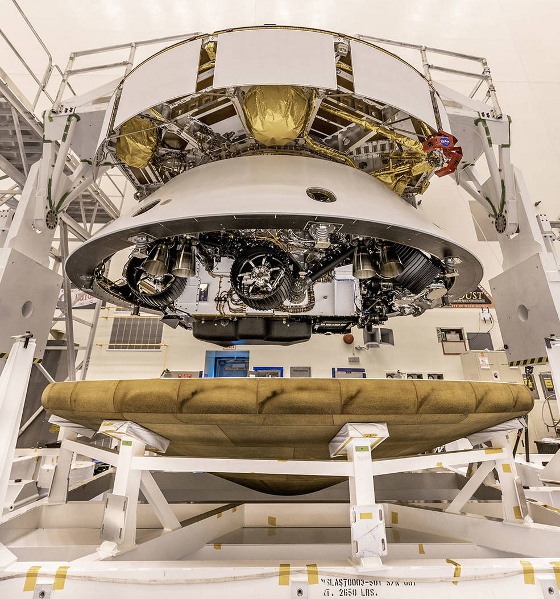
The Mars 2020 Perseverance rover mission's disk-shaped cruise stage sits atop the back shell, which contains the powered descent stage and Perseverance rover, with the Mars Ingenuity helicopter attached to the rover's belly. The brass-colored heat shield below is about to be attached in this image taken on May 28, 2020, at Kennedy Space Center in Florida. [Credits: NASA/JPL-Caltech/KSC]
The Red Planet's surface has been visited by eight NASA spacecraft. The ninth, Mars 2020 -- which carries the Perseverance rover and the Ingenuity mini helicopter -- will be the first that includes gathering Mars samples for future return to Earth. Launch is targeted for July 30. Encased in the nose cone, NASA's Perseverance Mars rover has already been attached to the top of an Atlas V booster rocket at Cape Canaveral. maxon's precision DC and BLDC motors will be used for numerous mission-critical tasks.
maxon drive systems are very familiar with Mars. Their drives have been used in virtually every successful robotic mission over the last three decades. There are now more than 100 of them on the Red Planet, and there are likely to be more soon with NASA's latest mission.
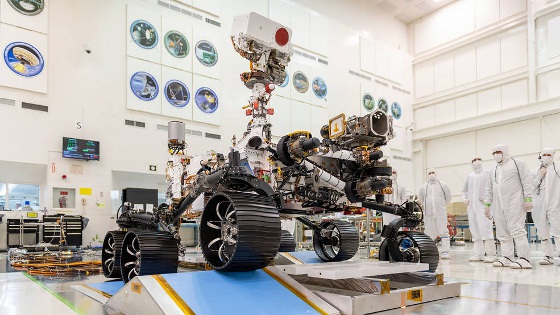
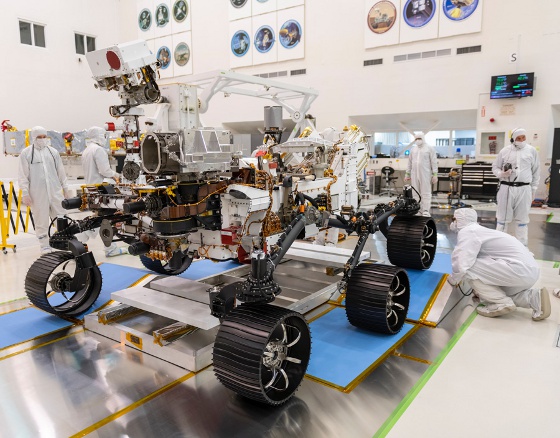
In a clean room at NASA's Jet Propulsion Laboratory in Pasadena, CA, engineers observed the first driving test for NASA's Mars 2020 rover on Dec. 17, 2019. [Credits: NASA/JPL-Caltech]
On July 30, the Atlas V rocket will launch the new Perseverance rover on its way to Mars, where it will be searching for signs of previous life on the planet. Its most important job is to take multiple soil samples, seal them in containers, and deposit them on the surface of Mars so that a future mission can return them to Earth.
Several maxon motors will be used to handle the samples inside the rover. For example, maxon DC motors are installed in the robotic arm, which moves the samples from station to station. maxon motors will also be used for sealing and depositing the sample containers.
TESTING: How it works: NASA's Perseverance Mars Rover Sample Caching System. [Credit: JPL]
NASA's Jet Propulsion Laboratory (JPL) is carrying out the mission. JPL asked maxon to produce 10 drives for the rover. As with almost all previous Mars missions, these drives are based on standard products from maxon's catalog -- with modifications.
For the first time, NASA is using brushless DC motors, including nine EC 32 flat and one EC 20 flat in combination with a GP 22 UP planetary gearhead. Working closely with JPL specialists, maxon engineers developed the drives over several years and tested them thoroughly to achieve the highest standards of quality.

Nine maxon EC 32 flat motors and one EC 20 flat motor in combination with a GP 22 UP planetary gearhead will help drive the Mars Perseverance rover's sampling system. [Photos: JPL (rover), © maxon (motors)]
"We've learned a lot from this exciting project," says Robin Phillips, head of the maxon SpaceLab. "We now have very broad expertise in space applications and have established quality assurance processes that meet the expectations of the industry. Customers from other industries such as the medical sector, where requirements are often similar, can also benefit from this know-how."
Space missions place the highest demands on drive systems, including vibrations during the rocket launch, vacuum during the journey, impacts on landing, and the harsh conditions on the surface of Mars, where temperatures fluctuate between -125 and +20 C and dust penetrates everywhere.
First helicopter flight on Mars -- and maxon's inside
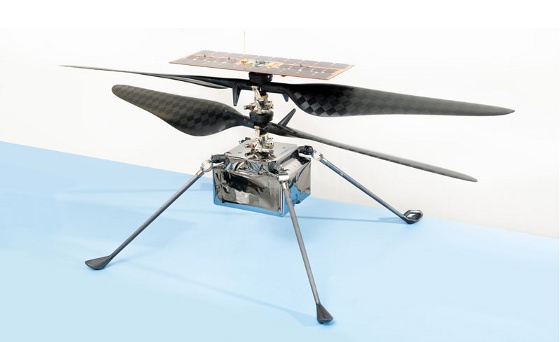
The flight model of NASA's Ingenuity Mars helicopter. [Credit: NASA/JPL-Caltech]
The Perseverance rover is expected to land on Mars on February 18, 2021, but it won't be alone. A drone helicopter called Ingenuity is attached to the underside of the rover. It weighs 1.8 kg (4 lb), is solar powered, and will perform several short flights, as well as take aerial images. The main goal of this experiment is to test the concept for future drones of this kind. maxon has six brushed DCX motors with a diameter of 10 mm controlling the tilt of the rotor blades and the direction of flight.
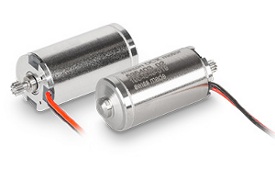
Six brushed DCX motors from maxon will control the tilt of the rotor blades and the direction of flight for the Mars Ingenuity helicopter. [Photo: © maxon]
The drives are very light, dynamic, and highly energy efficient. These properties are crucial, because every gram counts on the Mars helicopter. Flying on Mars is not easy. The atmosphere is extremely thin, roughly comparable to the conditions on Earth at an altitude of 30 km.
The drone helicopter has flown in a simulated test environment in the JPL laboratory. Whether it will lift off on Mars remains to be seen. First, other obstacles, such as the rocket launch, must be successful. Then the helicopter must be successfully unpacked from the bottom of the Perseverance rover.
"We hope that everything goes well and that we'll soon see our drives in action on Mars," says maxon CEO Eugen Elmiger. "We're all keeping our fingers crossed."
-------------------------------
SIDEBAR: How the Ingenuity copter will be unpacked and prepped to fly on Mars
By NASA JPL
NASA's Ingenuity Mars Helicopter will travel with the Perseverance rover through 314 million miles (505 million km) of interplanetary space to get to the Red Planet. But for the team working on the first experimental flight test on another planet, engineering the final 5 in. of the journey has been among the most challenging of all. To safely navigate those few inches, the distance Ingenuity will travel from where it's stowed on the rover to the surface of Mars, they came up with the ingenious Mars Helicopter Delivery System.
"Ingenuity is unlike any other helicopter ever built because powered controlled flight at Mars is unlike anything ever attempted," said MiMi Aung, project manager of the Mars Helicopter at NASA's Jet Propulsion Laboratory. "And then we had to figure out how to hitch a ride and safely get deployed from the Mars 2020 Perseverance rover."
VIDEO: Testing the Mars helicopter delivery system on NASA's Perseverance Rover. [Credit: JPL]
Ingenuity's square fuselage (which houses computers, cameras, batteries, and the like) is about the size of a softball (7.9 x 6.3 x 5.5 in.). But if you look outside the box, you'll find plenty of other important stuff -- including an antenna, solar panel, landing legs, and two rotors measuring 4 ft across -- that makes stowing and deploying the helicopter a challenge. The entire package tips the scales at about 4 lb.
"On a Mars rover mission, the addition of even one new washer is usually worthy of debate," said Chris Salvo, the helicopter interface lead of the Mars 2020 mission at JPL. "The Ingenuity Mars Helicopter is a large, fragile, unique assemblage of hardware that is dissimilar to anything NASA has ever accommodated on a planetary mission."
Mission engineers considered every available parking space on the rover chassis for their unusual addition, including the robotic arm. They eventually landed on Perseverance's belly, which on a relatively flat stretch of Red Planet surface should offer about 26 in. of ground clearance. While that may seem like a lot of room (an Earthly SUV provides about a third of that), the delivery system reduces that distance by about 2 in. Ingenuity is about 19 in. tall. This is where the 5-in. journey comes in.
Ingenuity will be deployed about two months after Perseverance lands on Feb. 18, 2021. During early surface operations, both the rover and helicopter teams will be on the lookout for potential airfields -- a 33 x 33-ft patch of Martian real estate that is comparatively flat, level, obstruction-free, and viewable by Perseverance when the rover is parked about a football field away.
On around the 60th Martian day, or sol, of the mission, Perseverance will drop the Mars Helicopter Delivery System's graphite composite debris shield that protected the helicopter during landing. Then it will drive into the center of the chosen airfield. About six days later, after the helicopter and rover teams are satisfied everything is a go, they'll command Mars Helicopter Delivery System to do its thing.
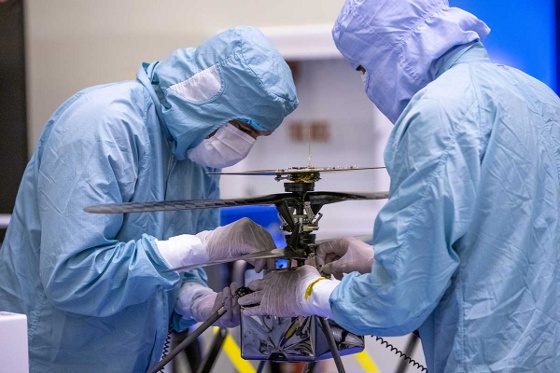
Functional testing of NASA's Mars Helicopter and its cruise stage occurred in the airlock inside Kennedy Space Center's Payload Hazardous Servicing Facility on March 10, 2020. (This is a great photo, because you really get a sense of the size of the copter. Much bigger than you probably thought!) [Photo: JPL]
The deployment process begins with the release of a locking mechanism that keeps the helicopter in place. Then a cable-cutting pyrotechnic device fires, allowing a spring-loaded arm that holds the helicopter to begin rotating Ingenuity out of its horizontal position. Along the way, a small electric motor will pull the arm until it latches, bringing the helicopter body completely vertical with two of its spring-loaded landing legs deployed. Another pyrotechnic fires, releasing the other legs.
"And all the while, the deployment system has to maintain electrical and data cable connections between rover and helicopter until it's ready to drop," said David Buecher, deployment system manager at Lockheed Martin Space in Denver, which built the system.
"While I have worked on my fair share of space-based deployment systems, this one was on another level," he said.
If all goes well, mission controllers will command the delivery system to release, and Ingenuity will cover those last 5 in. Once a good drop is confirmed, Perseverance will be commanded to drive away so the helicopter can begin recharging its batteries with its solar panel. At that point, the 30-sol clock on Ingenuity's flight test program begins.
The Ingenuity Mars Helicopter is an experimental flight test of new technology. Future Mars missions could enlist second-generation helicopters to add an aerial dimension to their explorations. They could act as scouts for human crews, carry small payloads, or investigate cliffs, caves, deep craters, and other unvisited or difficult-to-reach destinations. But before any of that happens, a test vehicle has to prove it's possible.
And before the test vehicle can do any of that, it has to land safely on the surface of Mars.
"Ingenuity needs Perseverance," said Aung. "The Mars Helicopter Delivery System is an ingenious gizmo and just one of the examples of how the Mars 2020 mission has worked above and beyond the call to accommodate our test project. Along with it and the helicopter, they had to incorporate an electronic base station and antenna dedicated entirely to helicopter operations into the rover. Our teams had to work closely together to make this complex system work. When Ingenuity flies, it will be an achievement we can all share."
Of course, the whole mission first needs to ace the Earth launch and the long space travel to Mars, and then it will need to survive Martian atmospheric entry. This is the "7 minutes of terror" maneuver made famous by the successful landing of the Curiosity rover in 2012.
VIDEO: 7 Minutes of Terror: The challenges of getting to Mars. The Curiosity rover's harrowing journey. [Credit: JPL]
We could watch this maneuver 50 times, and it would still seem incredible. Good luck, Perseverance and Ingenuity.
Sources: maxon motor, NASA/JPL
Published July 2020
Rate this article
View our terms of use and privacy policy
